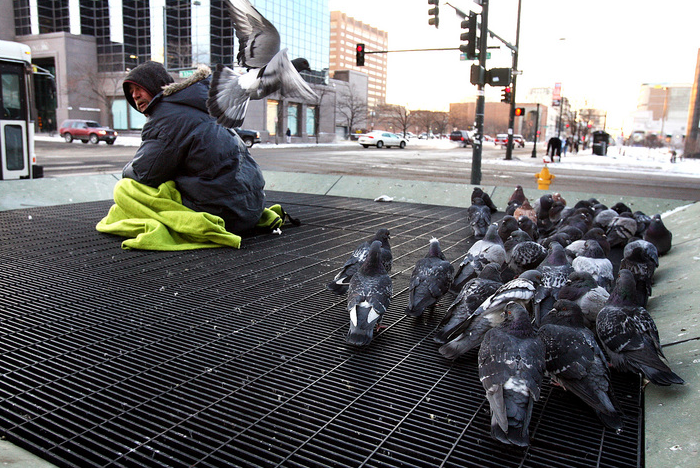Earlier this week Hariman commented on how the camera aids our fundamental desire to anthropomorphize animals, to see them “as being like us,” by directing our attention to their eyes—the windows to the soul—which allow a special point of identification and contact between humans. And the evidence is pretty compelling, made all the more so when we consider the obverse, i.e., photographs that underscore the zoomorphic representation of humans as if they were animals.
The photograph here is of “Michael Lantzy, 55, and some pigeons kept warm by spending the night on a steam grate in Denver.” According to the caption Lantzy has been homeless for four years, and identifying him by name would seem to distinguish his humanity from the pigeons with which he shares the limited space of public warmth, as does the very physical separation between the lone individual and the clustering flock of birds. But there is a strong sense in which the image resists the humanizing impulse of the caption, making it hard to see Lantzy as a distinct individual, or quite possibly even as human.
Pigeons are an urban nuisance. They are believed to carry communicable diseases and their nesting habits are squalid. Cleaning up after the mess they leave behind can be both costly and dangerous. The homeless are often characterized in similar terms and the photograph here accents the point of identity. Shot from a slightly elevated angle, it directs the viewers attention downward to the ground where homeless and pigeons alike are obtrusively roosting at the intersection of a public thoroughfare. The oblique angle from which the viewer observes the scene diminishes the difference in size between man and flock, while his gun-metal grey coat blends in almost perfectly with the colors of the birds’ plumage. The overall effect is to accent sameness and to undermine difference, even as it denaturalizes the landscape. This last point is important, for it is unlikely that the average pedestrian would view the scene portrayed here from this vantage as they walk by on their way from one place to the next. The photograph thus frames a somewhat exotic view (as if in a zoo) of the urban landscape.
One might be inclined to view the photograph as an ironic comment on a public and communal immorality—treating humans as vermin—but to do so requires us to recognize and acknowledge a clear difference between human and non-human in the picture. To this end, one might point to the lime-green blanket on which the man rests as a sign of a primitive, human instinct, but pigeons (like the homeless) are also notorious scavengers, and so what might function otherwise as a humanizing distinction is weighted down in this photograph by the more pronounced points of animalistic similarity. What is needed to disrupt the zoological analogy is something that gives direct and pronounced access to the man’s soul, a sense of his inner-being, his humanity, that would make it difficult or even impossible for another human to ignore his plight or presence. It is to my own shame that when I encounter a homeless person on the street I will often avert my gaze so as to avoid eye contact—the demand for human recognition—as if to make the “problem” before me disappear. And in this photograph it is notable that we have no access to the man’s eyes (as we have no access to the birds’ eyes) and thus nothing that would demand that we recognize his unique humanity. Just as we anthropomorphize animals by accenting the human quality of their eyes, so we animalize (dehumanize) strangers by erasing (or otherwise “veiling”) the windows to their soul.
But there may yet be an important and productive irony animated by the photograph. For while the man is identified with the pigeons he is also quite clearly separate from them. Indeed, the pigeons seem to treat him with the same kind of benign and nonchalant neglect that tends to animate our public response to the homeless (when it doesn’t devolve into out-and-out violence). Like most of us, they choose not to see him, even as they hold him at some distance. It gives new meaning to the phrase “a bird’s eyes view.”
Photo Credit: George Kochaniec Jr./AP

Worse yet, the pigeons have each other, while he has been abandoned by the other members of his species.
[…] from the “human family.” And the exclusion is doubly ironic, for just as we (shamelessly) avert our eyes from the homeless we encounter sleeping in alleys or panhandling on street corners, refusing to […]
Is this photo protected under copyright? Would like to use or purchase it. Who would I contact about this?
Evelyn: You might try contacting the photographer or the Associated Press.